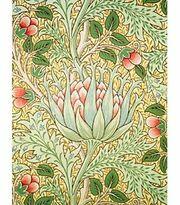The Industrial Revolution had taken England and America to a whole new level of monotonous production in terms of forms, lines, and patterns. The Art and Crafts Movement that took originated towards the end of the 19th century was an attempt at breaking this monotony. (Shiner, 2003. p 56 to 68)

A wallpaper by John Henry Dearle, titled “Artichoke”. This was produced for William Morris and Co., in the year 1897. This picture shows the bright palette that artists of the time used as resistance to the industrial revolution’s colors, in order to define spaces.
The Arts and Crafts movement was marked by reformist art aimed at a revistalist trend. Most of the architects and artists of this period were concerned with bringing to the fore the grandeur of the Victorian era. (Cumming, 1991. p 8) The art of this period went beyond mere buildings and exteriors and permeated into accessories and other objects that defined interiors and spaces in asymmetrical lines. These included wallpapers, mosaics, windows, chests, and other such objects. This period also showed the use of various kinds of material like Rattan and cane. (Greensted, 1999. p 11),
The character of this period is made up of its artisans. These include Augustus Welby Northmore Pugin as well John Ruskin. While John Ruskin rose to popularity with a style of his own as he brought back the Gothic style with a universal appeal in bold structures with heavy windows and spires, A W N Pugin was of the school of thought where medievalism was the best style of ornamentation. The Oxford University Museum is a perfect example of Ruskin’s work, as are his literary volumes like “The Stones of Venice”, which offer criticisms of various buildings and structures. (Shiner, 2003. p 61 to 88).

The most important characteristic of this particular period in art history is the fact that the artists and architects of this era drew from various schools of design and art in order to form a signature style of their own. This was the underlying idea behind resisting the effects of the Industrial Revolution on art – the aspiration to create a personal style that would be devoid of the typical features of the products and designs of this period. This is a trait that has been demonstrated by Sir Edwin Lutyens in his use of a canvas that spans the Mughal style of architecture. With his affinity for Chattris and Chujjas, it came as no surprise when this architect was commissioned to create a war memorial in Delhi (India). This resulted in the creation of space so open, warm and beautiful, that the Indians still flock here. This area, with its marks and gardens, set around the India Gate, depicts the true Indian spirit. Known as “Lutyen’s Delhi”, this is one of the poshest and expensive places for residence in Delhi, where only ministers and generals of the army get accommodation. (Greensted, 1999. p 23 to 25).
Not one to be left behind, Philip Webb was an artisan who drew from Anglo Japanese influences to define his sense of style. This can be seen in the picture below, of the Red House at Bexleyheath, Kent (England). Known for its unusual hue as well as the well-structured dome-like roofs, this house became a benchmark of sorts for those with revolutionary ideas. Crafted by Philip Webb, this house demonstrated a bright quality that was a strong characteristic of this period in art history. (Shiner, 2003. p 91).

Developed around the same time are revolutionary buildings that stand out on the horizon of art and design, like the Houses of Parliament. What set this period apart was also a trend of exhibitions and displays like the Great London International Exhibition of 1962. This trend soon caught on all around Europe with an “art for all” kind of theme. The Art and Craft movement took place in America simultaneously, yet there was an affinity for the bourgeois in their version of the movement. (Cumming, 1991. p 12 to 15).
With practitioners like William Morris, Robert Ashbee, Richard Lethaby, Ernest Gimson, Sidney Barnesley, Peter Waals, Edward Barnsley, Charles Voysey, Frank Wright, the Arts and Craft movement was enriched further to imbibe an element of art into the lives of the working class as well. Belonging to the Pre Raphelite era, these artists took it upon themselves to reinvent the essence of art as it was before the Industrial Revolution, instead of losing that essence to the same. The name of William Morris here is an important one considering the fact that he led a social revolution of sorts by taking to various styles of art and promoting the same. (Shiner, 2003. p 89 to 93)Another notable practitioner on the scene was a spinster named Getrude Jekyll. Her specialty included playing with gardens and imbibing a touch of green into empty spaces. Jekyll and Lutyens had been close partners in the design and both followed a more vernacular course of things when it came to decorating. This let them explore the charm of drawing from various influences like Anglo Japanese as well as Mughal and Victorian. (Greensted, 1999. p 25 to 27).
Conclusion
In conclusion, it would be fitting to say that the Arts and Craft movement was a revolution of sorts for the fact that it managed to thrive along with the blackness of the Industrial Revolution, where they’re so many issues emerging on the socio-economic and political scene. To have managed to capture the essence of art and its importance and reinvent the same to suit a personal sense of style – that too at a time when being unique was slowly fading away – was indeed an important aspect of that period. (Shiner, 2003) This form of revival in art has been hailed as a trend of sorts that was followed by subsequent schools of design including modern art with its themes of fusion, as well as schools of art like abstract expressionism, suprematism, dada, futurism, and many others. It also managed to usher an era of minimalism in its simplistic means of expression. The basic theme that was followed during the arts and crafts movement was one of constant reinvention so as to garner universal appeal through the structuring of various art forms including buildings, which has carried on until today. It is something that is taught in various art schools. This has been in practice since the time of W R Lethaby and Baillie Scott as they endeavored to teach the world how art must not be reformed merely for the sake of it but in order to reform a society plunging into darkness. In this way, this period of art history provided a deep sense of satisfaction and a wide medium of expression. There was constant experimentation and fusion. (Greensted, 1999) The whole atmosphere was one filled with a fusion of the tired and tested classic, and the unseen modern. This style catered to the fancies of the rich entrepreneurs and provided solace to the hard-working laborer. Through its various styles and structures, the Arts and Crafts movement during the end of the 19th century was successful in helping people survive the Industrial Revolution and its black madness. This era left its effects on the world of art as it endured subsequent schools of thought and philosophy. In doing so, it became one of the most effective periods in art history. Thus, it improvised on the earlier schools of art to emerge as a unique era of art.
References
Conferences: UK. 2007. Web.
Shiner, L. The Invention of Art: A Cultural History. (2003) “University of Chicago Press”
Greensted, M. The Arts and Crafts Movement in the Cotswolds. (1999). “Alan Sutton Publishing.”
Cumming, E. Arts and Crafts Movement. (1991). “Thames and Hudson.”